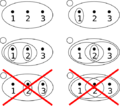Topology (nonfiction)
In mathematics, topology (from the Greek τόπος, place, and λόγος, study) is concerned with the properties of space that are preserved under continuous function deformations, such as stretching and bending, but not tearing or gluing.
Topology can be studied by considering a collection of subsets, called open sets, that satisfy certain properties, turning the given set into a topological space.
Important topological properties include connectedness and Compact space.
Topology developed as a field of study out of geometry and set theory, through analysis of such concepts as space, dimension, and transformation.
Such ideas go back to Gottfried Leibniz, who in the 17th century envisioned the geometria situs (Greek-Latin for "geometry of place") and analysis situs (Greek-Latin for "picking apart of place").
Leonhard Euler's Seven Bridges of Königsberg Problem and Polyhedron Formula are arguably the field's first theorems.
The term topology was introduced by Johann Benedict Listing in the 19th century, although it was not until the first decades of the 20th century that the idea of a topological space was developed.
By the middle of the 20th century, topology had become a major branch of mathematics.
In the News
Topological spaces charged as accessories to crimes against mathematical constants.
Fiction cross-reference
Nonfiction cross-reference
- Geometry (nonfiction)
- Gottfried Leibniz (nonfiction)
- Leonhard Euler (nonfiction)
- Mathematics (fiction)
- Topological space (nonfiction)
External links:
- Topology @ Wikipedia
